The medium voltage utility distribution panel market is expected to grow from USD 2.2 billion in 2025 to USD 3.7 billion by 2035, registering a 5.2% CAGR and generating an absolute dollar opportunity of USD 1.5 billion. Growth is driven by rising demand for reliable electricity distribution in industrial, commercial, and utility sectors, modernization of aging infrastructure, and integration of smart grid technologies.
Advanced panels offer enhanced safety, modular design, and improved monitoring capabilities, supporting adoption across developed and emerging markets. Rolling CAGR analysis highlights year-over-year variations in growth momentum throughout the forecast period. From 2025 to 2028, rolling CAGR remains slightly below the long-term average, reflecting steady adoption in North America and Europe, where replacement of outdated panels and infrastructure upgrades drive incremental growth. Between 2029 and 2032, rolling CAGR rises above the average as Asia Pacific, Latin America, and the Middle East expand utility networks, supported by industrialization, urbanization, and government investment in power distribution infrastructure. From 2033 to 2035, rolling CAGR moderates as early-adopting regions approach higher penetration, with incremental revenue increasingly derived from retrofits, maintenance, and system upgrades rather than new installations.
The USD 1.5 billion opportunity demonstrates a consistent expansion trajectory, with rolling CAGR revealing early steady growth, mid-period acceleration, and late-stage stabilization across the global medium voltage utility distribution panel market between 2025 and 2035.
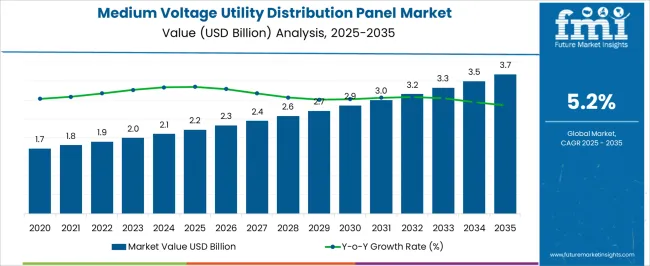
| Metric | Value |
|---|---|
| Medium Voltage Utility Distribution Panel Market Estimated Value in (2025 E) | USD 2.2 billion |
| Medium Voltage Utility Distribution Panel Market Forecast Value in (2035 F) | USD 3.7 billion |
| Forecast CAGR (2025 to 2035) | 5.2% |
The medium voltage utility distribution panel market is primarily driven by the electricity distribution and utility sector, which accounts for around 48% of the market share, as panels are essential for managing, protecting, and controlling medium-voltage power in substations, grids, and transmission networks. The industrial and manufacturing segment contributes about 22%, deploying medium-voltage panels for process plants, heavy machinery, and energy-intensive operations. Commercial infrastructure represents close to 15%, integrating panels in large buildings, campuses, and smart facilities for reliable power distribution. Renewable energy projects, including solar and wind farms, account for roughly 10%, connecting generation units to the grid.
The remaining 5% comes from transportation, rail, and municipal projects requiring robust, durable, and scalable medium-voltage distribution solutions. The medium voltage utility distribution panel market is advancing with innovations in digital monitoring, smart control, and compact design. IoT-enabled panels allow real-time performance tracking, predictive maintenance, and remote fault detection, improving grid reliability. Modular and pre-assembled designs simplify installation and scalability in industrial, utility, and renewable applications. Arc-resistant and safety-enhanced panels are gaining adoption to protect operators and reduce downtime. Integration with renewable energy systems, microgrids, and energy storage is expanding deployment in modern electrical networks. Manufacturers are focusing on energy efficiency, advanced protection mechanisms, and regulatory compliance. Growing electricity demand, infrastructure modernization, and the adoption of smart grids continue to drive global market growth.
The medium voltage utility distribution panel market is experiencing steady growth due to increasing investments in grid modernization, urban infrastructure expansion, and energy efficiency initiatives. Governments and utilities are upgrading aging power distribution systems to support higher loads, enhance grid stability, and integrate renewable energy sources.
The demand for compact, reliable, and low maintenance switchgear and panel solutions is growing, particularly in urban and semi urban areas where space optimization is critical. Technological advancements in smart panel integration, fault detection, and remote monitoring are further accelerating adoption.
The market outlook remains favorable as utilities seek to reduce power outages, meet regulatory compliance, and improve energy management capabilities, driving the need for advanced distribution panels in both new and retrofit projects.
The medium voltage utility distribution panel market is segmented by mounting, and geographic regions. By mounting, medium voltage utility distribution panel market is divided into Flush mounting and Surface mounting. Regionally, the medium voltage utility distribution panel industry is classified into North America, Latin America, Western Europe, Eastern Europe, Balkan & Baltic Countries, Russia & Belarus, Central Asia, East Asia, South Asia & Pacific, and the Middle East & Africa.
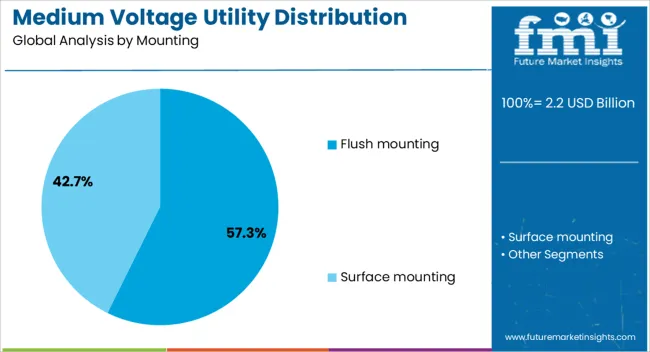
The flush mounting segment is projected to contribute 57.30% of total market revenue by 2025 within the mounting category, positioning it as the dominant installation method. This is due to its space saving design, clean finish, and enhanced safety features which make it highly suitable for densely populated urban areas and commercial infrastructure.
Flush mounting offers ease of access and minimal intrusion into interior spaces, which is especially important in high traffic utility zones and constrained installations. Additionally, the rising demand for modular and aesthetic electrical systems in modern substations and infrastructure projects has reinforced the preference for this configuration.
As utilities and infrastructure developers prioritize efficiency, durability, and streamlined integration, flush mounting has emerged as the preferred standard, driving its leadership in the mounting segment.
The medium voltage utility distribution panel market is expanding due to increasing demand for reliable power distribution, grid modernization, and industrial electrification. Asia Pacific leads with approximately USD 8.5 billion in installations in 2024, with China (USD 4.2 billion), India (USD 2.5 billion), and Japan (USD 1.8 billion). Europe accounts for USD 6.2 billion, led by Germany (USD 2.5 billion), France (USD 1.8 billion), and UK (USD 1.9 billion). North America holds USD 5.8 billion, primarily the USA, while the rest of the world represents USD 1.5 billion. Key applications include utilities (50%), industrial facilities (30%), and commercial establishments (20%), supporting 3–36 kV voltage ranges.
Growth is fueled by rising electrification, renewable energy integration, and increasing industrial energy demand. Utilities account for 50% of deployments, industrial facilities 30%, and commercial establishments 20%. Asia Pacific leads at USD 8.5 billion, Europe USD 6.2 billion, and North America USD 5.8 billion. Medium voltage panels typically support 3–36 kV circuits with rated current of 400–3,000 A. Grid modernization projects, including smart grid initiatives covering over 100,000 km of transmission lines in Asia Pacific, require upgraded panels to ensure reliability. Industrial automation and energy-intensive manufacturing facilities increase adoption of modular, compact panels capable of remote monitoring and protection coordination.
Key trends include modular designs, intelligent monitoring systems, and arc-resistant construction. Approximately 30% of new panels feature intelligent monitoring for real-time voltage, current, and fault detection. Modular panels allow capacity expansion of 50–150% without full replacement, deployed in 25% of industrial installations. Arc-resistant designs, used in 20% of utility and industrial panels, improve operator safety by preventing incident energy exposure. Integration with SCADA and IoT-enabled systems supports predictive maintenance, reducing downtime by 15–20%. Adoption of compact gas-insulated switchgear for 12–36 kV applications is increasing in Europe and Asia Pacific to optimize space and reduce installation time.
Opportunities exist in utilities, industrial plants, and commercial facilities. Utilities account for 50% of adoption, industrial facilities 30%, and commercial 20%. Asia Pacific is projected to reach USD 10 billion by 2027, Europe USD 7 billion, and North America USD 6.5 billion. Expansion of renewable energy projects, including solar and wind farms exceeding 150 GW in Asia Pacific, creates additional demand for medium voltage distribution panels. Industrial parks and smart manufacturing facilities require panels capable of remote monitoring and protection coordination. Integration with energy management systems can reduce operational costs by USD 15,000–25,000 annually per facility.
High initial costs, maintenance complexity, and regional regulatory variations restrict adoption. Medium voltage panels cost USD 25,000–150,000 per unit depending on voltage rating and configuration. Installation and retrofitting in existing infrastructure can increase project cost by 15–20%. Skilled personnel are required for commissioning and maintenance, adding USD 5,000–10,000 annually for large facilities. Compliance with IEC, ANSI, and local utility standards increases certification and testing expenses by USD 3,000–5,000 per panel. Supply chain constraints for circuit breakers, busbars, and monitoring modules can delay deployment by 4–6 weeks, particularly in developing regions.
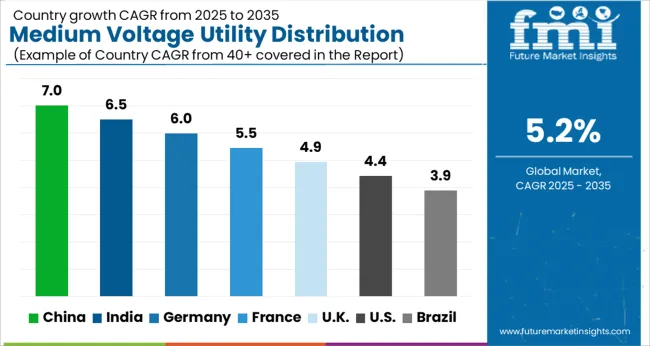
| Country | CAGR |
|---|---|
| China | 7.0% |
| India | 6.5% |
| Germany | 6.0% |
| France | 5.5% |
| UK | 4.9% |
| USA | 4.4% |
| Brazil | 3.9% |
The medium voltage utility distribution panel market is projected to grow at a global CAGR of 5.2% through 2035, driven by rising demand for reliable power distribution, industrial electrification, and infrastructure modernization. China leads at 7.0%, a 1.35× multiple over the global benchmark, supported by BRICS-driven expansion in industrial facilities, urban electrification projects, and utility upgrades. India follows at 6.5%, a 1.25× multiple of the global rate, reflecting growth in power distribution networks, industrial adoption, and urban infrastructure development. Germany records 6.0%, a 1.15× multiple of the benchmark, shaped by OECD-backed innovation in distribution panels, energy efficiency solutions, and smart grid integration. The United Kingdom posts 4.9%, 0.94× the global rate, with adoption concentrated in commercial facilities, infrastructure modernization, and retrofitting projects. The United States stands at 4.4%, 0.85× the benchmark, with steady uptake in industrial, commercial, and utility power distribution systems. BRICS economies drive most of the market volume, OECD countries emphasize advanced technology and efficiency, while ASEAN nations contribute through expanding industrial and utility electrification.
The medium voltage utility distribution panel market in China is projected to grow at a CAGR of 7.0%, driven by expanding power infrastructure, industrial facilities, and modernization of utility networks. Domestic suppliers such as CHINT Group, TBEA, and Delixi Electric provide high-performance distribution panels with advanced load management, modular designs, and remote monitoring capabilities. Technological developments focus on safety, energy efficiency, and reliability under high load conditions. Adoption is concentrated in power generation, industrial plants, and commercial infrastructure.
The medium voltage utility distribution panel market in India is expected to grow at a CAGR of 6.5%, supported by industrial expansion, urban infrastructure development, and modernization of power distribution networks. Key suppliers such as L&T Electrical, ABB India, and Schneider Electric provide panels with high reliability, modular designs, and advanced protection features. Adoption is concentrated in industrial zones, commercial facilities, and power utilities. Technological improvements emphasize load management, energy efficiency, and safety compliance.
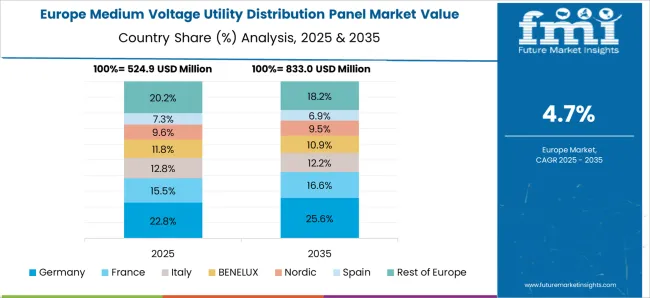
Germany’s medium voltage utility distribution panel market is projected to grow at a CAGR of 6.0%, influenced by demand from industrial automation, renewable energy integration, and modernization of commercial facilities. Suppliers such as Siemens, Schneider Electric, and Rittal provide high-performance panels with modular designs, smart monitoring, and enhanced safety features. Demand is concentrated in industrial plants, utility grids, and commercial infrastructure. Technological focus includes energy efficiency, compact designs, and operational reliability.
The medium voltage utility distribution panel market in the United Kingdom is expected to grow at a CAGR of 4.9%, driven by modernization of commercial infrastructure, industrial energy management, and expansion of power distribution networks. Suppliers focus on modular panels with enhanced safety, load management, and smart monitoring capabilities. Technological developments emphasize energy efficiency, reliability, and operational performance. Adoption is concentrated in industrial facilities, commercial buildings, and power utilities.
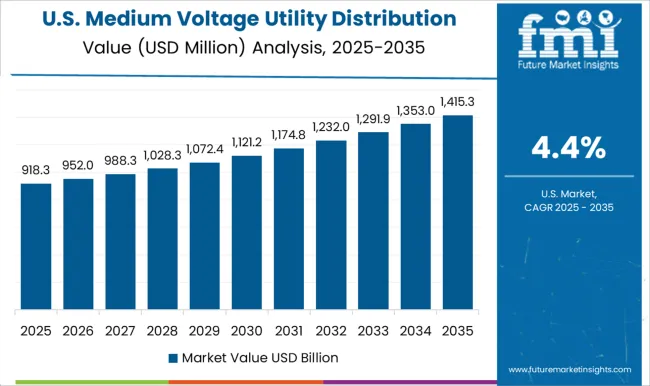
The medium voltage utility distribution panel market in the United States is projected to grow at a CAGR of 4.4%, supported by industrial automation, power infrastructure upgrades, and commercial expansion. Major suppliers such as Eaton, ABB, and Schneider Electric provide panels with modular designs, load management, and smart monitoring features. Technological improvements focus on operational reliability, energy efficiency, and rapid load transfer. Adoption is concentrated in industrial, commercial, and utility infrastructure.
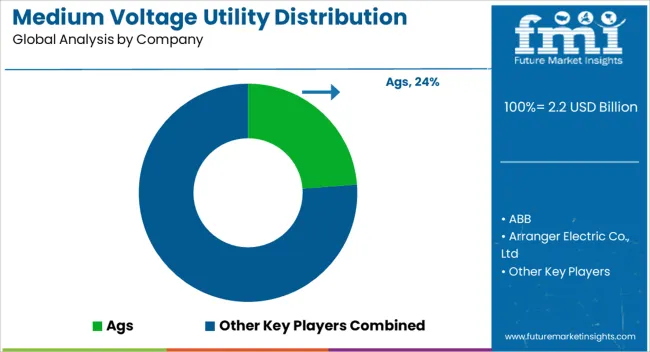
Competition in the medium voltage utility distribution panel market is being shaped by electrical reliability, safety, and adaptability for power distribution in industrial, commercial, and utility-scale applications. Market positions are being reinforced through modular designs, advanced circuit protection, and global support networks that ensure consistent performance, system longevity, and compliance with international standards. Ags and ABB are being represented with panels engineered for high-load capacity, fault protection, and operational efficiency. Arranger Electric Co., Ltd. and alfanar Group are being promoted with solutions structured for modularity, ease of installation, and scalability. Eaton and ESL POWER SYSTEMS, INC. are being applied with systems optimized for robust performance, thermal management, and high fault withstand capability. EAMFCO, General Electric, Hager Group, and INDUSTRIAL ELECTRIC MFG are being showcased with panels designed for automation integration, monitoring, and energy efficiency. Legrand, Larsen & Toubro Limited, Meba Electric Co., Ltd., and Norelco are being advanced with customizable panels engineered for precise load management and operational safety. NHP, Paneltronics, RBaker, Schneider Electric, Siemens, and Symbiotic Systems are being represented with solutions optimized for medium voltage control, electrical protection, and long-term reliability in complex distribution networks. Strategies in the market are being centered on modularity, safety enhancements, and system integration for digital monitoring and control. Research and development are being allocated to improve circuit reliability, fault detection, thermal resilience, and compatibility with smart grid technologies. Product brochures are being structured with specifications covering rated voltage, current capacity, number of feeders, enclosure type, and installation requirements. Features such as modular construction, fault protection, monitoring compatibility, and low maintenance are being emphasized to guide procurement and deployment planning. Each brochure is being arranged to present technical performance, certification compliance, and service support. Information is being provided in a clear, evaluation-ready format to assist utilities, electrical contractors, and procurement teams in selecting medium voltage utility distribution panels that meet reliability, safety, and operational performance requirements.
| Item | Value |
|---|---|
| Quantitative Units | USD 2.2 Billion |
| Mounting | Flush mounting and Surface mounting |
| Regions Covered | North America, Europe, Asia-Pacific, Latin America, Middle East & Africa |
| Country Covered | United States, Canada, Germany, France, United Kingdom, China, Japan, India, Brazil, South Africa |
| Key Companies Profiled | Ags, ABB, Arranger Electric Co., Ltd, alfanar Group, Eaton, ESL POWER SYSTEMS, INC., EAMFCO, General Electric, Hager Group, INDUSTRIAL ELECTRIC MFG, Legrand, Larsen & Toubro Limited, Meba Electric Co., Ltd, Norelco, NHP, Paneltronics, RBaker, Schneider Electric, Siemens, and Symbiotic Systems |
| Additional Attributes | Dollar sales by panel type and end use, demand dynamics across utilities, industrial, and commercial sectors, regional trends in grid modernization, innovation in safety, modularity, and smart monitoring, environmental impact of material use and disposal, and emerging use cases in renewable integration and microgrids. |
The global medium voltage utility distribution panel market is estimated to be valued at USD 2.2 billion in 2025.
The market size for the medium voltage utility distribution panel market is projected to reach USD 3.7 billion by 2035.
The medium voltage utility distribution panel market is expected to grow at a 5.2% CAGR between 2025 and 2035.
The key product types in medium voltage utility distribution panel market are flush mounting and surface mounting.
In terms of , segment to command 0.0% share in the medium voltage utility distribution panel market in 2025.






Our Research Products

The "Full Research Suite" delivers actionable market intel, deep dives on markets or technologies, so clients act faster, cut risk, and unlock growth.

The Leaderboard benchmarks and ranks top vendors, classifying them as Established Leaders, Leading Challengers, or Disruptors & Challengers.

Locates where complements amplify value and substitutes erode it, forecasting net impact by horizon

We deliver granular, decision-grade intel: market sizing, 5-year forecasts, pricing, adoption, usage, revenue, and operational KPIs—plus competitor tracking, regulation, and value chains—across 60 countries broadly.

Spot the shifts before they hit your P&L. We track inflection points, adoption curves, pricing moves, and ecosystem plays to show where demand is heading, why it is changing, and what to do next across high-growth markets and disruptive tech

Real-time reads of user behavior. We track shifting priorities, perceptions of today’s and next-gen services, and provider experience, then pace how fast tech moves from trial to adoption, blending buyer, consumer, and channel inputs with social signals (#WhySwitch, #UX).

Partner with our analyst team to build a custom report designed around your business priorities. From analysing market trends to assessing competitors or crafting bespoke datasets, we tailor insights to your needs.
Supplier Intelligence
Discovery & Profiling
Capacity & Footprint
Performance & Risk
Compliance & Governance
Commercial Readiness
Who Supplies Whom
Scorecards & Shortlists
Playbooks & Docs
Category Intelligence
Definition & Scope
Demand & Use Cases
Cost Drivers
Market Structure
Supply Chain Map
Trade & Policy
Operating Norms
Deliverables
Buyer Intelligence
Account Basics
Spend & Scope
Procurement Model
Vendor Requirements
Terms & Policies
Entry Strategy
Pain Points & Triggers
Outputs
Pricing Analysis
Benchmarks
Trends
Should-Cost
Indexation
Landed Cost
Commercial Terms
Deliverables
Brand Analysis
Positioning & Value Prop
Share & Presence
Customer Evidence
Go-to-Market
Digital & Reputation
Compliance & Trust
KPIs & Gaps
Outputs
Full Research Suite comprises of:
Market outlook & trends analysis
Interviews & case studies
Strategic recommendations
Vendor profiles & capabilities analysis
5-year forecasts
8 regions and 60+ country-level data splits
Market segment data splits
12 months of continuous data updates
DELIVERED AS:
PDF EXCEL ONLINE
Medium Duty Truck Market Size and Share Forecast Outlook 2025 to 2035
Medium-duty Engine Market Size and Share Forecast Outlook 2025 to 2035
Medium Earth Orbit (MEO) Satellite IoT Market Size and Share Forecast Outlook 2025 to 2035
Medium Format Film Cameras Market Size and Share Forecast Outlook 2025 to 2035
Medium Density Fiberboard (MDF) Market Analysis - Size, Share, and Forecast Outlook 2025 to 2035
Medium-Chain Triglycerides Market Growth -Functional Fats & Industry Demand 2025 to 2035
Medium Carbon Steel Market
Medium Voltage Transformer Industry Analysis in North America Size and Share Forecast Outlook 2025 to 2035
Medium Voltage Cable and Accessory Market Size and Share Forecast Outlook 2025 to 2035
Medium Voltage Transformer Market Size and Share Forecast Outlook 2025 to 2035
Medium Voltage Commercial Switchgear Market Size and Share Forecast Outlook 2025 to 2035
Medium Voltage Residential Switchgear Market Size and Share Forecast Outlook 2025 to 2035
Medium Voltage Capacitor Bank Market Size and Share Forecast Outlook 2025 to 2035
Medium Voltage Wire and Cable Market Size and Share Forecast Outlook 2025 to 2035
Medium Voltage Digital Substation Market Size and Share Forecast Outlook 2025 to 2035
Medium Voltage Circuit Breaker Market Size and Share Forecast Outlook 2025 to 2035
Medium Voltage Electric Capacitor Market Size and Share Forecast Outlook 2025 to 2035
Medium Voltage Transmission Substation Market Size and Share Forecast Outlook 2025 to 2035
Medium Voltage Drives Market Analysis - Size, Share, and Forecast Outlook 2025 to 2035
Market Share Insights of Leading Medium Voltage Transformer Providers

Thank you!
You will receive an email from our Business Development Manager. Please be sure to check your SPAM/JUNK folder too.
Chat With
MaRIA